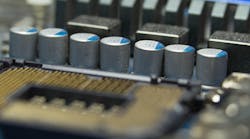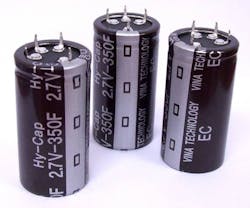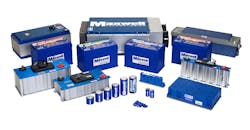The concept behind supercapacitors (sometimes called ultracapacitors) has drawn a lot of attention since conception due to the technology’s exceptionally high capacitance with an almost unlimited charge/discharge cycle life. Supercapacitors promise an operational voltage between 1 and 3 V for both organic and aqueous electrolytes, with the potential for incredible energy storage and rapid charging.
The potential to store electrical energy using an electric double layer at an interface between an electrolyte and solid compound has been known since the 19th century (source: Batteries & Energy Storage Technology 2007). However, it’s been a struggle to create a reliable application for the technology. The supercapacitor has come a long way since conception, and recent technologies certainly prove useful applications for the age-old electrical design.
A Brief History
The supercapacitor, or ultracapacitor, is electrically known as the electrochemical capacitor (EC) because it stores electrical charge in the electric double layer of a surface-electrolyte interface (source: Batteries & Energy Storage Technology 2007). This interface is primarily a high surface-area carbon. The large surface area, coupled with the tight area of the double layer, gives the device one of the highest capacitance outputs of any capacitor around.
The first electrochemical capacitor device was patented by General Electric’s H.I. Becker in 1957. Though a double-layer charge storage was used with this device, it was impractical because of the need to immerse it in a pool of electrolytes (source: Batteries & Energy Storage Technology 2007).
The standard EC design used today was invented by Robert A. Rightmire, a chemist at the Standard Oil Company of Ohio (SOHIO). SOHIO could not find a use for the application, but patented the design to the Japanese company Nippon Electric Company (NEC). NEC sold the first commercially viable EC in 1975, called the “Supercapacitor.” Though ECs today are commonly called supercapacitors or ultracapacitors, the only “true” supercapacitor is NEC’s brand of ECs of the same name.
Many other companies went on to design their own ECs shortly after NEC commercialized its design. ECOND, for example, manufactures the PSCap—an EC used as a starter for diesel locomotive engines. The PSCap can be as large as nine inches in diameter by two feet high, with energies up to 45 kJ, voltages up to 200 V, and an RC time-constant of less than a second. Research on the PSCap began in 1978 and was not realized until the mid-1990s.
Panasonic’s Goldcap EC is innovative in its applications, and research dates back to 1978. One Goldcap EC was designed to replace coin-cell batteries and was very successful in the solar-powered wristwatch market. The second design used a spiral-wound configuration targeted at electric vehicles and HEVs. Named the UpCap, the spiral-wound capacitor is rated at 2,000 F, with a voltage of 2.3V. It is also low-cost, with low series resistance, and dispels internally generated heat—ideal for use in hybrid-vehicle applications.
Current Specs
Most electronic companies today make ECs, including Maxwell, Murata, and Tecate Group. By and large, the technology is mostly used in transportation and energy solutions. Current applications include the automotive industry, hybrid transportation systems around the world, grid stabilization, utility vehicles, and rail-system power models.
Collection of Maxwell Supercapacitors and banks. (Source: Maxwell)
Tecate Group’s HC Series of Ultracapacitors are rated up to 150 F of capacitance, a voltage of 2.7, and maximum peak current at 65 A. Murata’s High-Performance Supercapacitor (EDLC) DMF Series exhibits the world’s highest output power, with a discharge of 50 W per piece. Murata also hails a quick charge/discharge cycle and the ability to level high peak loads for energy harvesting, energy-storage systems, and even consumer electronics.
One of the coolest applications that’s already available is the combination of supercapacitors with fuel cells for maximized energy storage and rapid charging capabilities. One example includes ABB’s rapid charging station that allows electric buses to fully charge in less than 10 minutes. The first commercial order for the application was placed in 2016.
Future Applications
As always, talk about supercapacitor technology isn’t without discussing plans for the future. We’re getting very close to standalone supercapacitor batteries. Researchers at the University of Central Florida successfully created a prototype supercapacitor battery that takes up a fraction of the space of lithium-ion cells, charges more quickly, and can recharge 30,000 times while still working like new.
Other innovations set to change the capacitor business include designing ECs with graphene to create lightweight supercapacitors with energy-storage capabilities between 150 F/g and 550 F/g, at a fraction of the price of current EC designs. Still, it’s a concept still being explored.
Realistic Applications
The most promising future of supercapacitors is the combination of a double-layer charging interface with existing energy-storage technologies. By adding EC technology to fuel-cell applications, companies have been successful in rapidly improving the charge/discharge cycle performance of hybrid- and electric-vehicle applications. Many cities using hybrid technologies for public transit have also seen an improvement in overall energy storage and charge cycles when coupling their energy systems with things like supercapacitor-based engine starters and charging stations.
The closest future application for supercapacitors is in energy storage and rapid charging. Many applications of this type have already hit the market, and are changing how we think about energy storage.
The realization of a commercially viable, standalone supercapacitor battery may be further off into the future. Still, supercapacitor applications that have been achieved are an exciting realization of part of an age-old technology that is only getting better with time.




